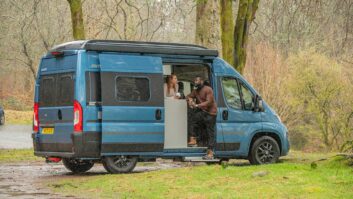While many people put their motorhomes away for the colder months, there’s an ever-increasing number of brave souls who use theirs year-round. Some go skiing, some go to Spain and Portugal chasing warmer climes, and some will even stay in good old Blighty. You have to bear in mind that not all motorhomes are suitable for winter touring in cold climates, though, so what can be done?
Any motorhome that has an underslung water tank will struggle in the colder weather – and any insulation provided is likely to be thin. You’ll need to protect water pipes under the floor, too. Low-wattage, 12V heater elements can be fitted to water tanks, but bear in mind that they might drain your battery if you’re not on electric hook-up. A ’van with an onboard freshwater tank is definitely preferable if you’re planning some four-season touring.
Waste tanks can be dealt with by leaving the drain tap open and keeping a bucket underneath to catch the grey waste. You’ll need to empty the bucket often, though.
Assess your heating
The second potential problem concerns the internal temperature of your ’van; it needs to be kept at a minimum of around 18 degrees to be comfortable to live in, and some may prefer it to be even warmer.
How warm your ’van will be depends on two things: the efficiency of the heating system, and how good the insulation is. Modern motorhomes are generally quite warm due to the majority of the wall structure being made of insulation, but bear in mind that cab windows can lose a huge amount of heat; in that instance, an external thermal screen cover will be a real godsend. Also, remember to close the fresh-air intake of the cab heater, because this is a common cause of draughts.
A good heating system in a well-insulated motorhome should be able to keep the interior at a comfortable living temperature, even when it’s well below freezing outside.
Reduce pressure
There are, however, other aspects of using a motorhome in winter that need consideration, and tyres is one.
Do you need winter tyres? If you’re only going to tour in the UK, then probably not: our winters generally aren’t harsh enough to need them (although 2010/2011 was an exception). If you’re going to mainland Europe, though, it could be a legal requirement that you have either winter-specific – or at least four-season – tyres fitted; you might also be required to carry snow chains.
On the subject of tyres, there is a little trick I’ll share with you for when you encounter low-grip weather – just let your tyres down! If you encounter snow or ice and can’t find any traction, letting up to 70% of the pressure out of your driving tyres will help massively (this also works on soft ground). Once you are moving, keep it smooth and slow – so no sudden movement of the accelerator or steering. Just make sure you can reinflate them once you are back on solid ground.
Brakes and batteries
From a base vehicle point of view, it’s also worth checking a few items in advance. First, ensure that your coolant has a sufficient strength of antifreeze.
Starter batteries come under the highest load during freezing weather, so it’s worth getting yours tested. I’ve known starter batteries to soldier on for 12 years, then suddenly fail at the first frost of winter. It will be easier and cheaper to replace yours before departing for a winter holiday, than having to get a recovery outfit to help you in your Alpine resort.
Get the brake fluid checked, too: it’s hygroscopic, which means that it attracts moisture out of the air. The water droplets combine and, because water is heavier than brake fluid, it sinks to the lowest part of the system.
Under heavy and extended braking, this water can boil due to the huge heat energy put in by the brakes. In winter there is another risk, though: the water might freeze in the wheel cylinders and stop the brakes from working at all! Get it checked, and if you’re in doubt, get it changed.
A keen motorcaravanner, Practical Motorhome’s technical expert Diamond Dave runs his own leisure vehicle workshop. Find out more at Dave Newell Leisure Vehicle Services.
When you encounter low-grip weather – just let your tyres down!









